14 Anthurium Types (Including a Care Guide and Pictures)

Many types of anthurium plants are some of the most stunning and unusual houseplants you’ll find. There are many species of anthurium that have brightly-colored waxy bracts or spathes (modified leaves) that look like flowers. Other varieties of anthurium plants have striking foliage with heart-shaped leaves and striking veined patterns. Although all varieties of anthurium plants are tropical flowering plants, with the right care, you can easily grow these exotic-looking plants indoors.
The most popular types of anthurium:
- The flamingo flower (Anthurium andreanum) with its lipstick-red waxy flower and shiny heart shaped foliage.
- Anthurium scherzerianum looks similar to the flamingo flower but has a curly spathe resembling a pig’s tail.
- The velvet cardboard anthurium (Anthurium clarinervium) with large deeply lobed leave and veined patterns.
- Black anthurium (Anthurium watermaliense) has flowers that are deep purple, almost black-looking.
- The bird’s nest (Anthurium hookeri) has large dark-green elongated leaves.
The most attractive feature of many anthurium cultivars is their flowers. The flower is a finger-like spike called spadix (plural spadices) that grows protruding from the spathe—the colorful plastic-looking leaf. The spathe—also called bract—can be flattened or curved similar to a peace lily. The spathes are usually deep, shiny red. The anthurium flowers can be red, white, orange, green, pink, purple or multi-colored.
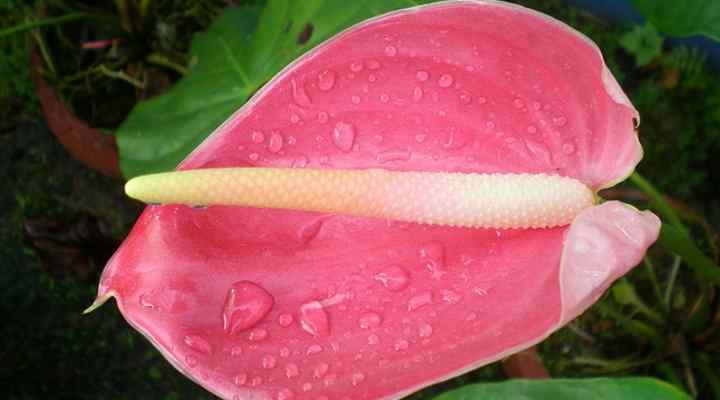
In this picture the creamy-yellow spike (spadix) is the flower, and the pink modified leaf is called bract or spathe
Of course, there are many hybrids and cultivars, each with unique features. Some variations on the flamingo flower are the pink anthurium with a light pink spathe and spadix, the dark purple anthurium with stunning deep purple almost black bracts, and the white anthurium with snow-white spathes and cream-colored spadices.

Anthuriums with red and white bracts
How to care for anthurium plants: tropical indoor plants such as anthuriums thrive in bright, indirect light growing in slightly moist, well-draining soil. Water when the top 1” to 2” (2.5 – 5 cm) of the soil is dry, keep humidity high and fertilize every other month during spring and summer. The optimal temperature range is between 70°F and 86°F (21°C – 32°C).
Anthurium plants are a type of aroid in the family Araceae. There are over 1,000 species of anthurium, and they are native to South and Central America were they grow in tropical rainforests. Anthurium plants thrive in warm, humid environments where the dense forest canopy protects their foliage from direct sunlight.
Growing indoors, many species of anthurium are ornamental houseplants that grow between 2 and 3 ft. high (60 – 90 cm). Common names for these tropical plants include flamingo flower, little boy plant, laceleaf, and tailflower.
Indoor flowering anthurium plants bloom throughout the year under ideal conditions. The blooms can last for many weeks, and the cut flowers keep their color for many months. Because of this, anthurium flowers are popular in cut flower arrangements.
In this article, you will learn about 14 of the most common species of anthurium.
Types of Anthurium With Pictures and Care Guide
Flamingo Lily (Anthurium Andreanum)
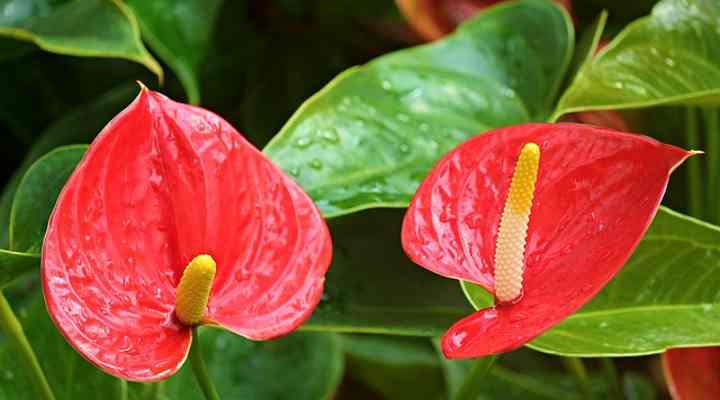
The Anthurium andreanum is also called the oilcloth plant as its bract looks like a red waxy plastic-like flower
Also called the flamingo flower, this species of anthurium is the plant often described as having red, plastic-looking flowers. The large red spathe is heart-shaped, glossy, and waxy. In the middle of the spathe is the spadix in the shape of a straight spike. The anthurium flower (spadix) is yellow and white. Flamingo lilies have dark-green, heart-shaped leaves that create bushy foliage.
Flamingo lilies bloom throughout the year if grown in warm temperatures, soil with good drainage, and high humidity. Apart from the flamingo lily with red flowers, some cultivars have orange, pink, purple, or white spathes and spadices. You may also find variegated types of flamingo lilies with pink and green or pink and white colors.
Flamingo lilies (Anthurium andreanum) are similar in appearance to the next plant on our list—Anthurium scherzerianum. The main differences between the two plants is that the flamingo lily has a straight flowering spadix with heart shaped bract and foliage. The next type has curled spadix with ovoid red bract and larger elongated leaves.
Anthurium Scherzerianum
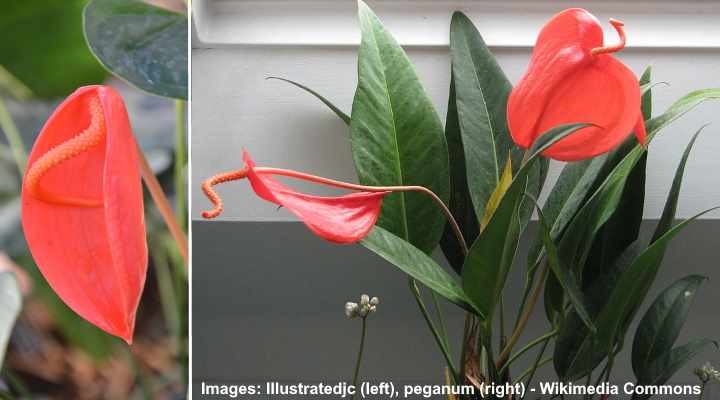
Anthurium scherzerianum is characterized by its curled spadix and elongated foliage
This species—Anthurium scherzerianum—has beautiful large, glossy lance-shaped leaves that taper to a point. The red flowers are made up of a flat waxy bract that curls downward and a pinkish spadix. This anthurium is sometimes called the flamingo flower or the pig’s tail anthurium. You will notice that the spadix is curled and twisted.
Similar to the Anthurium andreanum, there are many cultivars of this tropical plant. You can find exotic varieties of anthurium with multi-colored bracts that have shades of cream, green, red, and orange all on one bract. The spadix colors can also be in various shades. Some are single-colored spadices, and others have two tones.
Velvet Cardboard Anthurium (Anthurium Clarinervium)
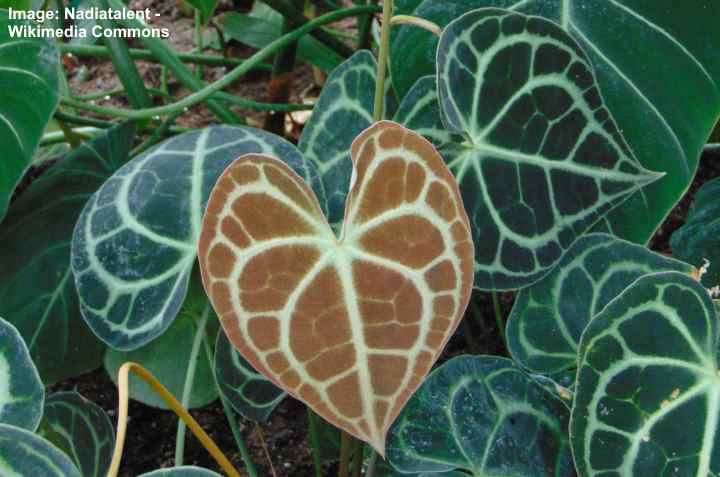
Anthurium Clarinervium has heart shaped leather-like leaves with interesting vein patterns
The Anthurium clarinverium is a tropical species that is prized for its stunning green and white leaves. The foliage is made up of large, heart-shaped, oval large leaves that are a deep green color. Thick white veins provide stunning markings on the surface of the leaves. The leathery green leaves will add a touch of the tropics to any interior.
Although the velvet cardboard anthurium is a flowering species of plant, its blooms are inconspicuous. The flowers and spathes grow on the end of long stems. However, most houseplant experts advise snipping off the flowering stems to give more energy to the foliage growth.
Place this plant in a bright location, away from direct sunlight, to keep its brightly colored veins and dark green foliage vibrant. This plant species is also a type of climbing plant. So, you can train it to grow up a moss pole if you want to create a spectacular visual accent in any room.
Anthurium Ace of Spades (Anthurium Crystallinum)
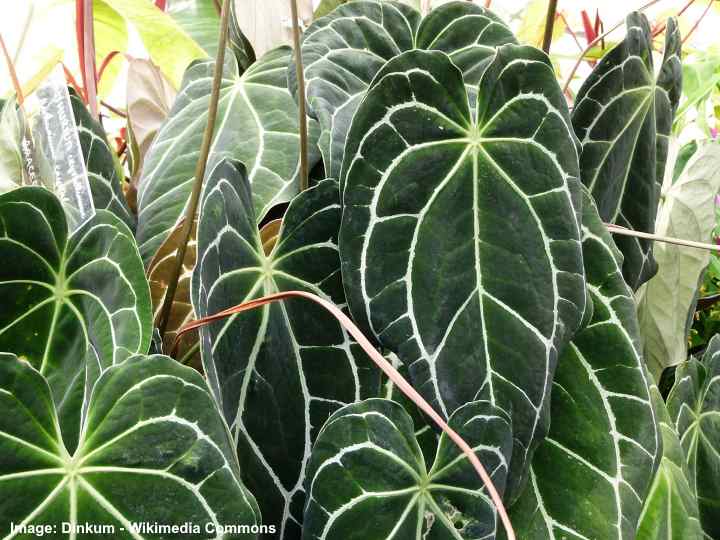
Anthurium Crystallinum has large elongated foliage with attractive vein patterns
Another popular species of evergreen anthurium that is grown for its foliage is the ‘Ace of Spades.’ This flowering plant has large, fuzzy oval leaves that can grow up to 2 ft. across. Similar to the velvet cardboard anthurium, the large heart-shaped leaves have prominent white veins. These seem to make the leaves sparkle.
The anthurium ace of spades grows up to 3 ft. (1 m) tall and has a broad spread. The flowers are made up of light green spadices and dark green spathes. However, there is nothing spectacular about the flowers. So, it’s best to prune them off to concentrate all the plant’s energy in its stunning foliage.
King Anthurium (Anthurium Veitchii)
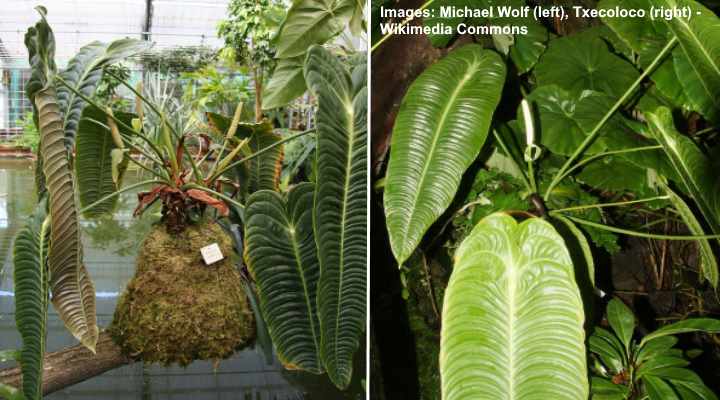
Anthurium Veitchii has large elongated pendulous leaves
Looking at pictures of this type of anthurium, and it’s easy to see why it’s called the king anthurium. This flowering tropical rainforest plant has huge leaves that can measure up to 1 ft. (30 cm) long indoors. However, in greenhouses or the tropics, the shiny green emerald leaves can grow to many feet in length. The lanceolate-shaped long leaves are thick and leathery and droop down over the side of the container.
Because of its long, pendulous leaves, the king anthurium is best grown in hanging baskets. In its native habitat, this plant tends to grow higher up in the forest. So, this plant can withstand more direct sunlight that other species of anthuriums.
Queen Anthurium (Anthurium warocqueanum)
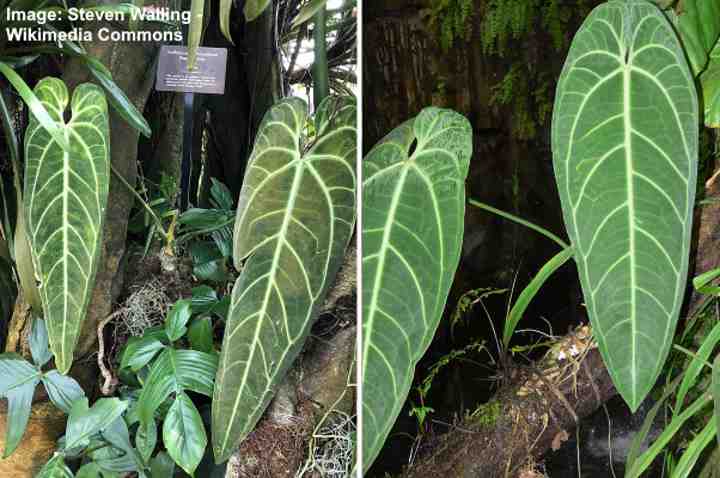
Queen Anthurium has large elongated and ornamental foliage
Another kind of anthurium that is prized for its stunning foliage is the queen anthurium. This species has large elongated lance-shaped velvety, dark-green leaves. The anthurium foliage features pronounced silver-white veins that contrast on the thick leaves. It has large leaves that under the ideal growing conditions can grow up to 6 ft. (2 m).
It’s important to keep the temperature warm and humidity high if you want to grow queen anthuriums indoors. Most people have success growing these anthuriums in hanging baskets or on a high shelf. This allows the large foliage to hang down over the container.
Anthurium Vittarifolium
The Anthurium vittarifolium plant is a type of strap-leaf anthurium due to its long thin pendulous leaves. The dangling leaves can grow up to 6 ft. (2 m) long and measure just a few inches across. When the anthurium blooms, it produces red flowers and pink berries that also dangle down over the side of the pot.
With this plant species, it’s the beautiful long narrow leaves that are the star attraction. They have a velvety glow and are excellent for providing greenery in any modern décor. One of the most spectacular cultivars of these plants is the variegated ones. These species of anthurium have dark green fuzzy leaves with lightly variegated yellow markings, giving the leaves a brushed appearance.
Anthurium Forgetii
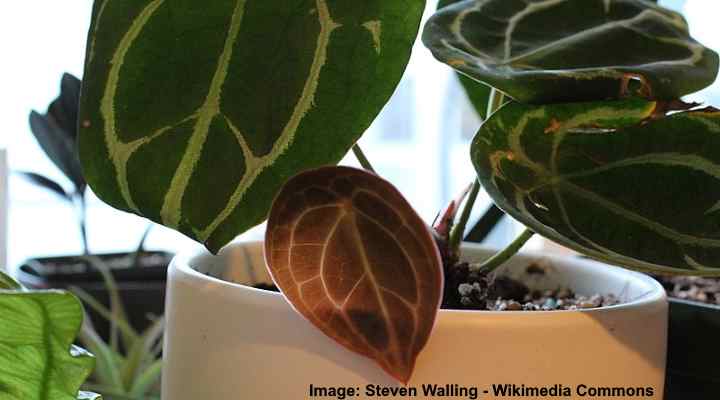
Anthurium forgetii leaves are completely ovate rather than heart shaped
The anthurium forgetii grows in its native habitat in Colombia and has adapted well as an indoor houseplant. One of the differences of this species is that the leaves are completely ovate without upper lobes. The upper lobes—also called sinus—are what give most anthurium plants their heart-shaped appearance.
The large velvety leaves are dark green with prominent white veins running through them. Glistening flecks on the leaves give them a somewhat shiny appearance. Anthurium forgetii produces green-colored spathes that have purple edging. The flowers are a light green to yellow color that can become orangey-red. After flowering, purple berries appear on the spike.
Black Anthurium (Anthurium watermaliense)
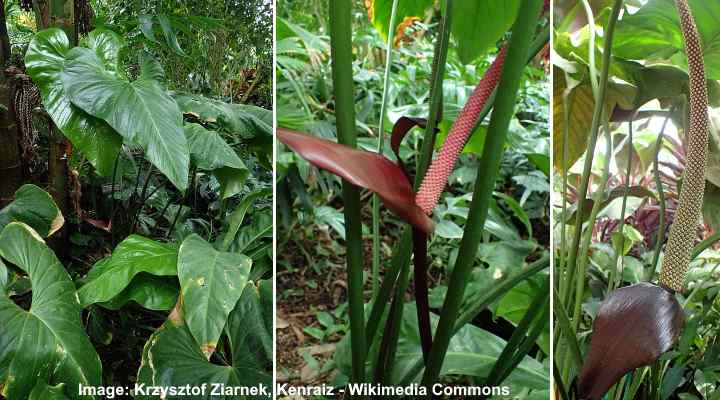
There are several cultivars of black anthuriums. In the picture: Anthurium watermaliense
The black anthurium is one of the most unusual houseplants that you can grow. The plant’s bracts look black, but they are, in reality, a very dark purple. The dark, chocolate-colored bract and flowers look stunning against the dark green, glossy anthurium leaves. The foliage grows in a rosette form and is classed in the “bird’s nest” group of anthuriums.
The Anthurium watermaliense leaves are lanceolate-shaped and deeply lobed. There are no prominent veined markings on the plant. These showy anthuriums bloom regularly indoors if you get the growing conditions right.
There is another species of anthurium that also has the common name ‘black anthurium.’ This is the Anthurium cabrerense, and it’s a tropical species that also has black flowers.

Other anthurium cultivars that produce dark, almost black bracts are ‘black beauty’, ‘black queen’ and ‘black love’
Bird’s Nest Anthurium (Anthurium hookeri)

The large elongate leaves of Anthurium hookeri grow in a pattern of bird’s nest
The Anthurium hookeri has the common name ‘bird’s nest’ even though other species have a similar growth pattern. This evergreen tropical plant is grown for its foliage rather than its green flowers. The shiny green leaves are an elongated oval shape that sometimes resembles a huge spoon. The anthurium hookeri also has characteristic tiny black dots on the green leaves that help to identify the species.
Bird’s nest anthuriums grow well in large containers indoors or as tender patio plants in temperate climates. When the anthurium is in bloom, it produces long purplish spikes (spadices) that stand erect. After blooming, small white berries appear on the spadix.
Anthurium Magnificum
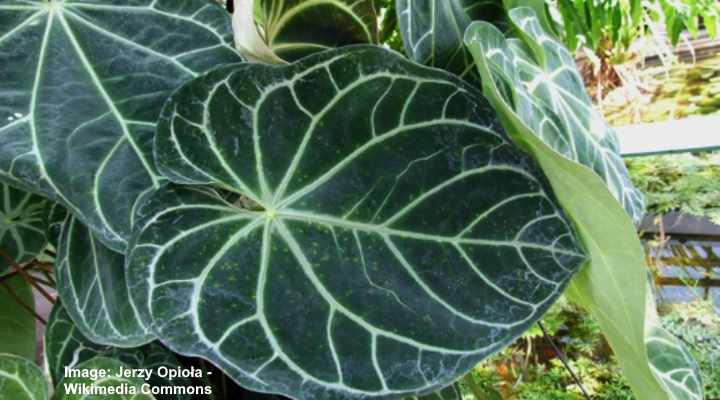
Young leaves of Anthurium Magnificum have burgundy hue before turning dark green
Another type of plant that is grown for its large foliage rather than flowers is the Anthurium magnificum. This species of plant has large heart-shaped, oval leaves that have prominent creamy-white veins. The Anthurium magnificum has velutinous (velvety) leaves. When new leaves appear, they are a brownish-burgundy color before they develop into a dark green.
The spadix of Anthurium magnificum plants is straight and a yellowish-green color. The spathe re-curves and is a green color.
Anthurium Pendulifolium
As its botanical name suggests, the Anthurium pendulifolium has long pendulous leaves that dangle downward. The long tapering green leaves make this species of anthurium suitable for hanging baskets. The shiny leaves measure a few inches wide but can grow up to 4 ft. (1.2 m) long.
The flowers on this anthurium species are inconspicuous. The spadix looks like a long purple spike. However, the spathe is pale green or creamy white and not noticeable.
Big Red Bird Anthurium (Anthurium Pachyneurium)
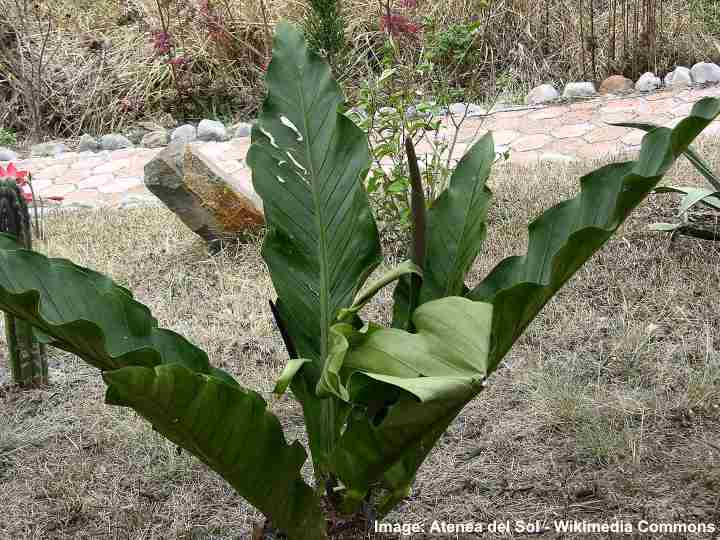
Anthurium Pachyneurium is characterized by the wavy edges of its leaves
The Anthurium pachyneurium is another type of bird’s nest plant. This species has broad, long, lanceolate leaves with very short stems (petioles). One of the distinguishing features of this tropical plant is the wavy edges of the leaves. This anthurium species is an excellent specimen plant for containers if you want to bring some of the tropics into your home.
This anthurium variety has a typical rolling pattern of its new leaves – whereas new leaves of other anthurium varieties resemble a single spiral, those of the Pachyneurium type are rolled in two opposite spirals that are rolled inward from both margins.
The common name of the ‘big red bird’ anthurium comes from the color of the leaves that turn reddish in bright light or cool temperatures.
Pearl Laceleaf (Anthurium Scandens)
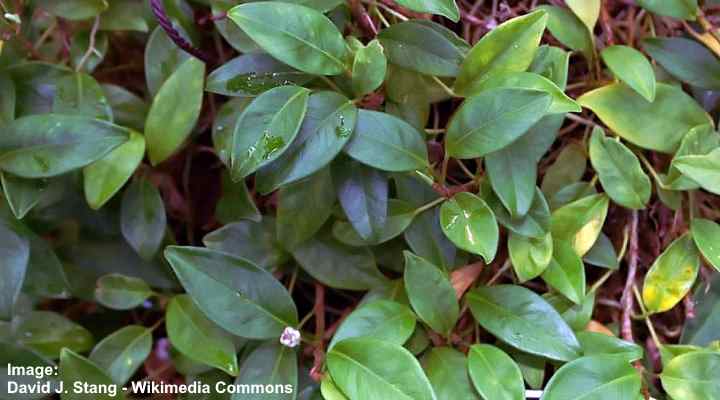
The pearl laceleaf anthurium is a climbing vine plant that is native to rainforests in Southern Mexico and Brazil. The plant has thick, matte green leaves that are oval to lance-shaped. These evergreen leaves grow to between 2.3” and 5” (6 – 13 cm) long.
The bract or this anthurium variety is light green and insignificant with yellowish-green spadix that turns to small white berry like fruits. The fruit looks like a cluster of white pearls, hence its common name pearl laceleaf. This plant makes quite a show when several clusters of these pearly white berries are hanging from the stems.
How to Care for Anthurium Plants
Most types of anthurium plants are relatively easy to grow indoors. The most popular variety of anthurium is the flamingo lily, which has bright red spathes and blooms with straight or curled spadices. How should you care for anthurium plants at home? Read on to find out.
Anthurium plants need plenty of indirect light
To encourage healthy, fast growth, grow your anthurium in bright, indirect light. The most important care tip is to protect your anthurium from direct sunlight. Too much sunlight can burn the leaves and turn them yellow or brown. If there is not enough light, the stems can become leggy and scraggly.
The best soil for anthurium plants
Anthurium plants need to grow in a potting mix that has excellent drainage. The roots need to be kept moist, but never too damp or soggy. You can make an ideal potting medium for anthuriums by mixing equal parts of peat moss, pine bark, and perlite. Alternatively, a commercial orchid potting mix is just as good.
How to water anthurium plants
Water anthuriums only when the top 1” to 2” (2.5 – 5 cm) of potting soil has dried out. To check when you should water the houseplant, press firmly on the soil. There should be no sign of moisture. Rather than hydrate on a set schedule, only water anthuriums as often as the soil partially dries.
Temperature and humidity
Average room temperature between 65°F and 86°F (18°C – 32°C) is ideal for anthuriums. However, they will grow faster in warmer temperatures with high humidity. Also, try to increase humidity levels as these tropical plants need humid conditions to thrive. If you don’t have a humidifier, mist the leaves daily or place on a pebble humidifying tray.
Other care tips when growing anthurium plants
- Pruning—Only prune dead or decaying foliage from the plant. No special pruning is needed.
- Repotting—Transfer the anthurium to a larger container every two to three years.
- Propagation—The best way to propagate anthurium plant is by root division. Remove the plant from its container and divide the roots into two or three sections. Each root section should have at least two stems.
- Pest and diseases— Know how to spot the signs of houseplant pests and act quickly to eradicate the aphids, spider mites, or mealybugs.
Anthurium Plants are Toxic
It’s essential to remember that all anthurium plants are toxic to humans and pets. Doctors say that ingesting parts of anthurium plants can cause oral inflammation and airway obstruction. So, keep the tropical plants away from children and animals. (1)
How to Care for an Anthurium (Flamingo Flower or Flamingo Lily)
Related articles:
